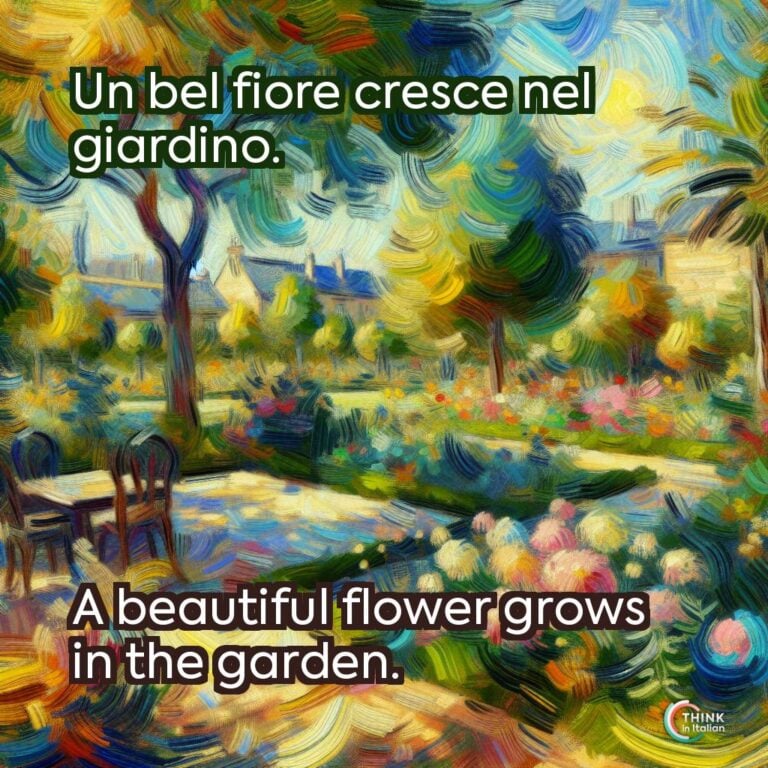What is Truncation?
Truncation, known as troncamento is the linguistic phenomenon where certain words are shortened when used in specific contexts to create a more informal expression or a more rhythmic or concise phrase.
Truncation is especially common with adjectives that precede masculine nouns and it must be distinguished from elision, which is the removal of a vowel and is indicated with an apostrophe (like l’amico for lo amico).
In Italian, truncation is more common in spoken language than in written language. However, some truncated words entered the Italian lexicon in their new truncated form and are used that way.
Let me show you some examples of truncation in Italian:
- Grande often becomes gran, as in un gran giorno (a great day).
- Santo becomes San before a consonant, like San Marco instead of Santo Marco.
- Buono becomes buon as in un buon amico (a good friend).
You can try it yourself: say the word buongiorno and hear how it easily rolls off the tongue, resulting also more pleasing to the ear. If you’re interested in developing a better ear for these nuances, focus on how to develop pronunciation skills.
Truncation in Italian
Buono
In Italian, truncation affects the word buono in a way that is very similar to how definite articles behave.
Just as the definite articles il and lo are used in different contexts based on the noun they precede, buono is truncated to adapt to the sound and flow of the sentence, especially before a singular masculine noun starting with a consonant or a vowel.
Exceptions apply for singular masculine nouns starting with z, gn, ps, s followed by another consonant.
For example:
Stefano ha un buono stipendio, ma non un buon superiore.
Stefano has a good salary but not a good boss.
Bello
Also the adjective bello (beautiful) undergoes truncation in a way that is very similar to that of definite articles. In fact, it becomes bel when it comes before a singular masculine noun that would normally take il as the definite article.
Dovresti leggerlo, è un bel libro.
You should read it, it is a good book.
I created a table that shows the comparison between the adjective bello and definite articles:
| Noun | Definite Article | Form of “Bello” | Example with Definite Article | Example with “Bello” |
|---|---|---|---|---|
| Libro (book) | Il | Bel | Il libro | Bel libro |
| Zaino (backpack) | Lo | Bello | Lo zaino | Bello zaino |
| Amico (friend) | L’ | Bell’ | L’amico | Bell’amico |
| Libri (books) | I | Bei | I libri | Bei libri |
| Studenti (students) | Gli | Begli | Gli studenti | Begli studenti |
| Casa (house) | La | Bella | La casa | Bella casa |
| Amica (female friend) | L’ | Bell’ | L’amica | Bell’amica |
| Case (houses) | Le | Belle | Le case | Belle case |
Uno
Uno is an indefinite article used used before singular masculine nouns that begin with a consonant cluster, namely a consonant followed by another consonant.
However, when uno precedes a singular masculine noun that starts with a regular consonant or vowel, it truncates to un. This is why saying un’albero is incorrect: the proper form is un albero.
The truncation rule applies here because albero (tree) is a masculine noun starting with a vowel, and in Italian, the indefinite article un does exist and is used specifically before singular masculine nouns that begin with a vowel.
The use of an apostrophe with un is reserved for feminine nouns only, as in un’amica (a female friend).
Truncated Words That Entered the Lexicon
As I mentioned at the beginning of this article, truncated forms are so prevalent in Italian that some of them became the default way of expressing certain phrases, evolving into fixed expressions within the language.
Over time, these truncations have let to the creation of compound words, that result from merging two words into one unified expression that is now a standard in the Italian lexicon.
For example, buongiorno (good morning) and buonanotte (good night) are formed by combining buon or buona (good) with giorno (day) and notte (night), respectively.
This process of truncation and compounding reflects the dynamic nature of the Italian language, where convenience and fluidity in communication often shape the evolution of words and phrases.
Understanding Truncation
Truncation isn’t arbitrary: it is governed by specific rules related to the phonology of words. Truncation rules are not just about making the language sound prettier, but they are about efficiency and fluidity.
Italian speakers value a rhythmical and harmonious flow in their speech. If you want to learn Italian, understanding these phonetic and grammatical rules is vital.
Learning why Italians say buongiorno instead of buono giorno opens a window into the beauty and complexity of the Italian language.








